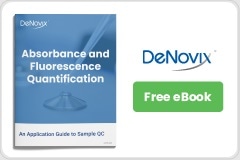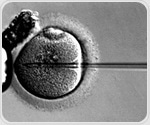| Genomics - Infographic - publication highlights for spatial analysis |
|
|
|
|
| |
|
| |
The latest genomics news from News Medical |
|
|
|
| |
 Free Application eBook: Absorbance and Fluorescence Quantification Free Application eBook: Absorbance and Fluorescence Quantification
Fluorescence and UV-Vis Absorbance are complementary measurement techniques for the quantification and quality control of samples. Each method has advantages depending on the application and sample being quantified. This free eBook by DeNovix contains resources about Absorbance and Fluorescence and explains when it's best to use each (or both).
| |
|
|
|
|
 | | |  A new study shows that total RPE65 protein levels in mice with autosomal dominant retinitis pigmentosa were doubled following subretinal delivery of adeno-associated virus (AAV)-RPE65 gene supplementation. A new study shows that total RPE65 protein levels in mice with autosomal dominant retinitis pigmentosa were doubled following subretinal delivery of adeno-associated virus (AAV)-RPE65 gene supplementation. | | | | |  A new study adds to an emerging, radically new picture of how bacterial cells continually repair faulty sections of their DNA. A new study adds to an emerging, radically new picture of how bacterial cells continually repair faulty sections of their DNA. | | | | |  The course of human history has been marked by complex patterns of migration, isolation, and admixture, the latter a term that refers to gene flow between individuals from different populations. The course of human history has been marked by complex patterns of migration, isolation, and admixture, the latter a term that refers to gene flow between individuals from different populations. | | | | |  A new treatment option has been discovered for fragile X syndrome, which is the most common genetic cause of autism spectrum disorders and is defined by a hereditary repetition of certain nucleotides in the DNA sequence of the FMR1 gene. Researchers at Massachusetts General Hospital (MGH) carried out the study, which was published in the journal Cell. A new treatment option has been discovered for fragile X syndrome, which is the most common genetic cause of autism spectrum disorders and is defined by a hereditary repetition of certain nucleotides in the DNA sequence of the FMR1 gene. Researchers at Massachusetts General Hospital (MGH) carried out the study, which was published in the journal Cell. | | | | |  A new instrument that has the potential to help minimize the spread of antimicrobial resistance is revealing early potential, by using a bacterial immune system as a gene-editing tool. A new instrument that has the potential to help minimize the spread of antimicrobial resistance is revealing early potential, by using a bacterial immune system as a gene-editing tool. | | | | |  Combining both genomics and proteomics is a significant benefit for many reasons, as this comprehensive approach can cover all disease associations within the body and reveal many biological targets for drug development. Combining both genomics and proteomics is a significant benefit for many reasons, as this comprehensive approach can cover all disease associations within the body and reveal many biological targets for drug development. | |
|
|
|
|
|
|